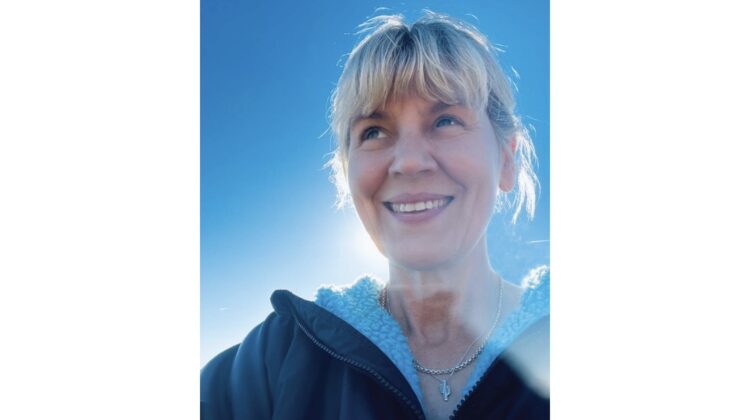
It’s apple season! For this month’s column, Suffolk-based artist and co-presenter on The Art Channel, Grace Adam appreciates orchards in art
I adore apples, so when I hear there’s a Lord Lambourne or a St Edmunds Russet in the neighbourhood, I’m there. It’s apple season of course. This got me thinking about artists and orchards. In a painting, fruit strewn across a tablecloth or nestling in a bowl with a nearby wasp is all about the transience of human life. Orchards, though, are full of promise and nourishment, sometimes sites of nostalgia or maybe a slight melancholy brought on by the end of summer?
Adam and Eve 1504 Albrecht Dürer

We all know that Eve took that apple, so apples can symbolise temptation, death, love, sexuality and knowledge. I suppose I’m stretching the idea of an orchard as Dürer’s Adam and Eve are deep in a dense European forest, but it’s such an accomplished and famous image, it’s worth scrutinising again, and there is fruit! Adam and Eve stand in very similar poses, weight on one leg; contrapposto, right arms bent upwards, left arms down.
Dürer travelled to Italy to study Leonardo da Vinci and Giovanni Bellini and was a big fan of Botticelli and ancient Greek sculpture. He was sold on the ideals of the Roman architect Vitruvius. Broadly based on (selective) human proportions Vitruvius believed these should be the principal source for proportions in architecture.
Dürer’s etching shows ‘perfectly proportioned’ humans getting into trouble in the Garden of Eden. The pair are flanked by four animals that represented the four temperaments: the cat, the rabbit, the ox and the elk; choleric, sanguine, phlegmatic and melancholic. Adam hangs on to the Mountain Ash, the Tree of Life whilst Eve grasps the forbidden Fig, representing the Tree of Knowledge. She reaches out to the centre of the image to receive that apple. As I’m more focussed on fruit than sin this month I won’t delve into that any more here. These orchards can be dangerous places.
It’s interesting to think that the contract between artist and patron; one work of art made for one client no longer applied. Dürer could share his ideas and his work through mechanical reproduction. Nuremberg became a centre of print publishing and Albrecht Dürer was right there.
The Orchard 1917 Paul Nash

Bare vulnerable trees stand in stark military formation in a bleached landscape. English artist Paul Nash said that he thought of “objects as personages”.
Nash was part of a WW1 regiment known as the Artists' Rifles when he was invalided out. In this painting two lines of barbed wire in the foreground form part of a visual geometry reminding us of the trenches. Later Nash returned to the front as an official war artist, where he tried to communicate what he witnessed. In a letter to his wife Margaret, he wrote ‘I am a messenger who will bring back word from the men who are fighting to those who want the war to go on forever. Feeble, inarticulate will be my message, but it will have a bitter truth and may it burn their lousy souls.’
His paintings reflect his deep affinity to the landscape; its power to show brutality and sadness as well as strange beauty.
His quiet works took on board European Modernism and are deeply rooted in the work of William Blake and JMW Turner. I encourage you to look him up if you don’t know his paintings. They stay with you.
The Orchard 1899 Pierre Bonnard

If these versions of an orchard have left you feeling that they are risky or melancholy places, I’ll leave you with a lovely funny little lithograph by French artist Pierre Bonnard.
Bonnard made intimate images of his home, his wife, his dogs and domestic life generally; modest subject matter for a painter who was an important link between the Impressionists and the Modernists. It’s up to you to decide whether you think its slightly too sweet or nostalgic and whimsical.
Grace Adam is a Suffolk-based Artist, Educator and Co-Presenter. Visit Grace Adam Artist and discover The Art Channel on youtube.com.
Featured images – supplied









I always tell students that Eve wanted knowledge and that Adam could have refused the apple. It’s like when my great grandfather told my grandmother that education oiled woman for marriage. Men wanted women with less knowledge so they were evil if they got knowledge wanted it.
Thanks for showing me the symbolism in the Diurer And another painting by Nash.
I love the little lithograph, thank for this article – so interesting!
Thank you for your orchards and art insights! From Somerset, where it’s all about the apples now. I do think apples assuage the melancholic autumn with their sweetness and it is my favourite time of year.
I’ve learnt a lot as always, including a new word ‘contraposto’! I shall endeavour to use it!